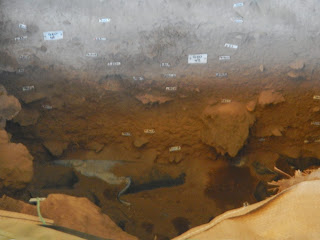 |
| View into the sandstone kloof where the walls are festooned with rock art. |
 |
| Approach to Salmanslaagte |
The sandstones of the Cedarberg weather to form rockshelters and caves easily.
 |
| Ben for scale in a rockshelter at Salmanslaagte |
 |
| Inside Salmanslaagte |
 |
| Closeup of panel |
 |
| More of Salmans' |
The upper pictures above show a panel with four woman in a row. You will see how their arms are raised, hands close together and fingers splayed, this panel is interpreted as women dancing and clapping. Cool. Now look more closely at the yellow part of the image, the women are superimposed over a giant elephant! See the trunk going down between the 2 women on the right? and the front legs below the group of people under the women? This picture indicates that it was painted at different times, on different occasions and possibly by different people. Suggesting a continual use of the shelter over a (long?) period of time.
 |
| Tourists! |
 |
| Hunter. See the bow? Also note the intrusion of a black fungus along the body of the figure (speckled areas) |
Rock art both in the Cedarberg and in other parts of the country tends to contain repetitive themes like men, women, hunting and many strange shapes.
 |
| The phoentician ship |
 |
| Closeup of the Phoenician ship - lower right |
 |
| Found near Salmans', see the boat? |
The interpretation of the meaning of rock art images and their importance and possible meaning to the people that created the rock art is a matter for much debate especially those strange shapes I mentioned. David Lewis-Williams bases his interpretations on shamanistic practices of modern day San hunter-gatherer groups. He suggests that these paintings were created by shamans (or the equivalent thereof) probably after ingestion of hallucinogens and that many of the themes represent spiritual concepts. He refers to the strange shapes as transcendentals. Over the last 20 or more years this thinking has come to dominate rock art interpretations.
Certainly there are many similarities between San traditions and images in ancient rock art and curiously there are no images of mundane, day-to-day, activities depicted in ancient rock art. However it is completly impossible to test any interpretations. Many agnostics to the Lewis-William school argue that some paintings clearly have very litteral meanings and that the shamanistic view point is being used too restrictively.
We sat in the cool of that shelter (many people still feeling quite fragile from the night before) for a long time discussing these questions.
 |
| Discussing the meaning of rock art |
In due course we returned to camp to complete the last few presentations. The conference finished off with Peter Gardenfors from Lund discussing the question of cognition. Cognition referrers (in this context) to modern human thinking. It encompasses things like cooperation, communication, planning, etc. And when you get down to it, this is the bedrock question around which archaeology is based. Lithic analysis of how stone tools were made, interpreting the meaning of painting, looking at what people were eating. It all come back to the same basic questions: When and how and why did we become essentially human?
It was easily one of the most fascinating talks of the conference but I must have been over 40C in that room, the aircons have given up the dust so I took in a lot less than I would like to have had. It was so hot in fact that my laptop kept crashing. I was using it to try to finish those diagrams for the publication I mentioned in a previous post. PS that publication will be appearing sometime in this month and they are using one of those figures for the cover of the magazine! How rad!
 |
| Archaeologist snare! Foolproof! 100% guaranteed to work! Step 1) Put out bag of rocks Step 2) Wait! |
 |
| The only way to cool down after a long conference. |
Next week we will discuss the journey home with a stopover at Diepkloof Rock Shelter.




















